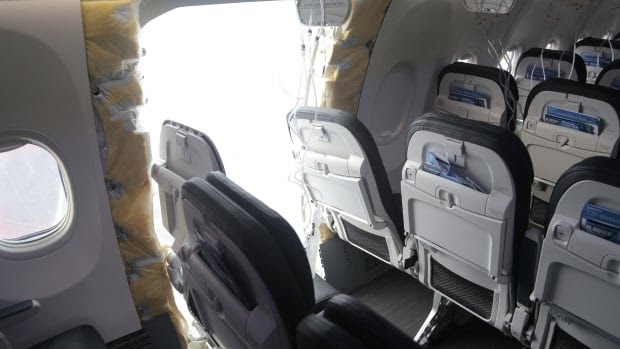
Passengers aboard Alaska Airlines Flight 1282 heard a loud bang and felt the plane suddenly drop as wind blew through the aircraft.

A few have spoken publicly about the shock of being on the Boeing 737 Max 9 jet that was forced to make an emergency landing last Friday night after a door-sized cabin panel blew off early in the flight.
The plane, bound for Ontario, Calif., east of Los Angeles, managed to return to Portland, Ore., and land safely, and none of the 171 passengers and six crew members were seriously injured.
But a trauma specialist says some people may be left with post-traumatic stress disorder, depending on the intensity of their feelings during the frightening but short-lived ordeal.
Steve Joordens, a psychology professor at the University of Toronto, said after the danger has passed, something seemingly unrelated to the initial event could act as a trigger, a sign of PTSD.
They may feel that same “existential threat,” or a sense their life could end, when they’re once again exposed to “something from the previous environment,” such as a random sound or smell on the plane just before the blowout, he said.
“They may leave that airplane with that association formed,” and if that stimulus comes up, that could trigger “the terror they felt the moment that window blew out,” Joordens told CBC News.
Passengers and crew were in the air for only a few minutes when part of the plane’s fuselage blew open, and they were soon back on the ground, but it was traumatic for some who said they didn’t know if they would survive.
‘I just really thought I was going to die’
Emma Vu, a swim coach in Portland and social media manager for the swimsuit brand Arena, was on the flight when a door plug detached from the fuselage and flew out.
She was asleep when she felt the plane drop, but she knew it was something “way different” than just turbulence when she saw the oxygen masks come down.
“And yeah, I started freaking out,” she told Reuters.
“In the moment … a lot of tears. I just didn’t know what was going on. But I think I will say that I feel that a lot of people around me were a lot calmer than I would have thought for a situation like this.”
Vu told Swimming World magazine that she started texting her family and friends, “and I just really thought I was going to die, which seems dramatic, but I really felt that way in the moment.”
She said she tried taking deep breaths during the rest of the flight, which she used to do before races, and once back on the ground to book a flight to Burbank, Calif., for the next day, she was able to talk about the experience to a fellow swimmer who stood in line with her.
A passenger named Courtney, who goes by @imsocorny on TikTok and posted video of herself wearing a mask on the flight, called the blowout “literally the scariest moment of my life.” She also said in the captions, “I still can’t believe this happened.”
Joordens said those closest to the torn fuselage may have experienced a higher level of existential threat, while those four or five rows away may not have felt enough danger to trigger PTSD, and by talking things through, they can recover relatively quickly.
Teen’s seatbelt saved his life, says passenger
The loud noise was startling enough, and the roaring wind that immediately filled the cabin left passenger Kelly Bartlett unnerved. Still, it wasn’t until a shaken teenager, shirtless and scratched, slid into the seat next to her that she realized just how close disaster had come.
“We knew something was wrong,” Bartlett told The Associated Press. “We didn’t know what. We didn’t know how serious. We didn’t know if it meant we were going to crash.”